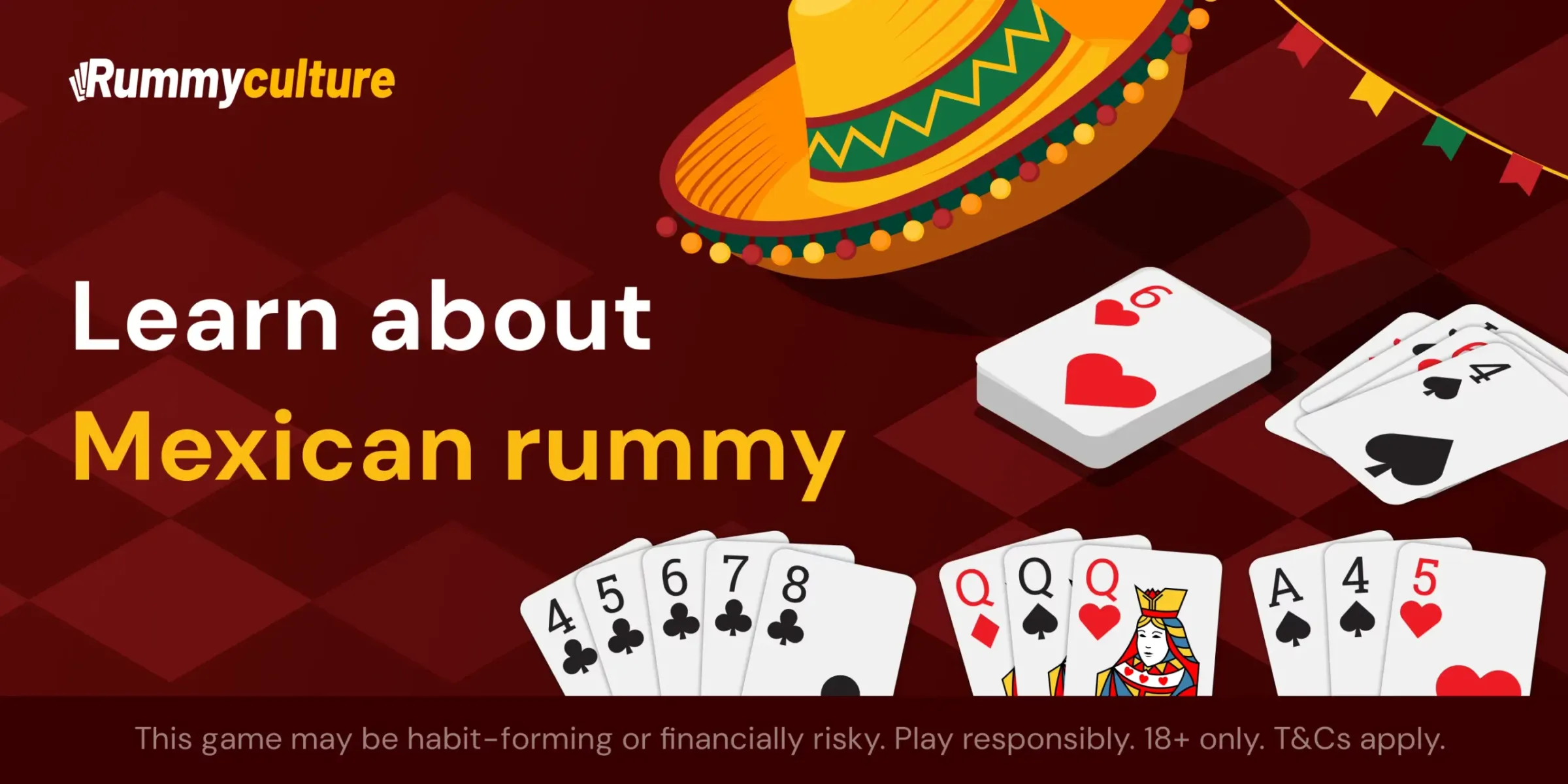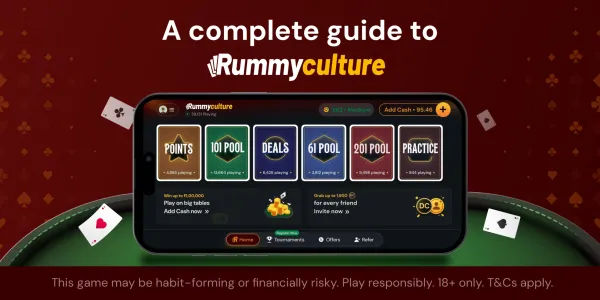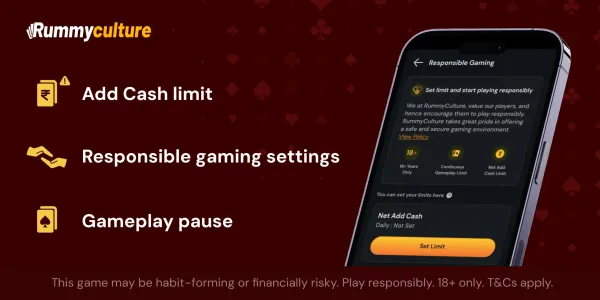- Home
- Rummy World
- What is Mexican rummy? Learn about its origin, rules, and gameplay
What is Mexican rummy? Learn about its origin, rules, and gameplay
One of the most popular variations of rummy in Latin America especially is the Mexican rummy or Rummy Mexicano, this card game is often played in family gatherings and social settings.
RummyCulture Elite Editors | 2nd Dec, 2024

What is Mexican rummy? Learn about its origin, rules, and gameplay
Rummy is easily one of the most exciting card games, and what makes it interesting is its various forms across the globe. Every continent has its own variations of rummy; all with different sets of rules and objectives. Most historians suggest that modern-day rummy may have originated from either Mexico or China and was then adapted locally in many different countries. Many variations of rummy are often a mix of other variations; for example, the 13-card Indian rummy is also a cross between gin rummy and 500 rum. You can read more about the different forms of rummy here.
One of the most popular variations of rummy in Latin America especially is the Mexican rummy or Rummy Mexicano. In Mexican culture, this card game is often played in family gatherings and social settings. Unlike the classic Indian rummy where the objective is to meld the 13 cards in hand into valid groups in all the rounds, Mexican rummy has a fascinating format where in each round players get a different number of cards and have to adhere to different grouping rules.
Read on to learn more about the rules of Mexican rummy and how the scoring system works.
Origin of Mexican rummy
While the exact origin of the Mexican rummy format is unknown, it draws closely from formats like Conquain and Rum, which originated in Mexico and the United States. Conquain is one of the earliest documented forms of rummy, and its rules differ greatly from those of its modern descendants. Mexican rummy is also very closely related to Contract rummy in terms of game structure.
Gameplay for Mexican rummy
Mexican rummy is usually played between 2-8 players and the number of decks (including Joker cards) used will depend on the number of players:
2 to 4 players: 3 decks
5 to 6 players: 4 decks
7 to 8 players: 5 decks
The number of decks used is a lot higher than traditional Indian rummy and most other rummy formats, because there are 11 rounds and different numbers of cards (from 10 to 13 usually) are dealt to each player.
The objective of a Mexican rummy game is more or less the same as traditional Indian rummy: to be the first one to declare. What a valid declaration entails is, however, different for Mexican rummy.
Mexican rummy is played over a preset number of rounds of phases, with each phase having a different objective in order to win. The following table is a handy guide to the objective of each phase:
| Round/Phase | What you need for winning |
| 1 | 2 sets of 3 cards each |
| 2 | 1 sequence of 4 cards + 1 set of 3 cards |
| 3 | 1 sequence of 7 cards |
| 4 | 1 set of 5 cards + 1 set of 2 cards |
| 5 | 1 sequence of 5 cards + 1 set of 3 cards |
| 6 | 2 sets of 4 cards each |
| 7 | 1 sequence of 8 cards |
| 8 | 1 sequence of 5 cards + 1 set of 2 cards |
| 9 | 1 sequence of 9 cards |
| 10 | 1 set of 5 cards + 1 set of 3 cards |
| 11 | 1 sequence of 10 cards |
The first player to lay down their cards with the groupings required in the particular phase is the winner.
Rules of Mexican rummy
Let us understand how to set up and play a game of Mexican rummy. There are some basic guidelines and terms a player must be familiar with.
Game setup and flow
Each player is dealt 11 cards in every phase. The remaining deck is placed face down at the centre of the table (the closed deck in Indian rummy), with the top card turned face up to begin the discard pile (or open deck). The player to the left of the dealer starts the game and it then proceeds clockwise.
Card values in Mexican rummy
The values of the cards in Mexican rummy are slightly different from those in Indian rummy. A comparison is given below:
| Card(s) | Indian rummy | Mexican rummy |
| Numbered cards (2 to 9) | As per face value | 5 points |
| K, Q, J, 10 | 10 points | 10 points |
| Ace | 10 points | 20 points |
| Joker cards | 0 points | 20 points |
The winner of a phase will get 0 points, while the other players will get points according to the ungrouped cards in their hand as per the card values listed above.
In Mexican rummy, cards are divided into ‘natural’ cards (cards that do not have any special value attached to them and can only be played as per their face value in that deal) and Joker cards (which include wild Joker cards). Like in Indian rummy, some groupings are supposed to be made just with natural cards (like a pure sequence) while others are allowed to have Joker cards in them.
Objective of Mexican rummy
Similar to Indian rummy, the main objective of a game of Mexican rummy is to create valid sets and sequences (also called a ‘run’).
Set: 3 or more cards of the same rank but different suits (such as 9♣️ 9♠️ 9♥️)
Sequence or Run: 3 or more consecutive cards of the same suit (such as A♦️ K♦️ Q♦️ J♦️)
In their turn, a player picks a card from either the closed deck or the open deck, adds to one of their groups, and discards a card they no longer need. As the players keep making different groups according to the phase, they have the option to lay down the groups on the table in public view. This is something we don’t do in a game of Indian rummy, where all the groups need to be declared together.
Going out
When a player keeps getting the necessary groups for a phase, they can lay them down one by one in public view and declare. Then, once all groups are laid, the player makes a declaration. This act is called ‘going out’.
Hitting
Once a player has laid down their completed groups for the phase, they have the choice to ‘hit’ the groups laid out by other players. Hitting is basically disposing of one’s card into another player’s laid-out groups.
Hitting is only valid once a player has ALL required groups of a phase ready. For example, if the player is in Phase 4 (1 set of 5 cards + 1 set of 2 cards), only after they’re done laying 5 + 2 cards on the table can they start discarding the 4 remaining cards in their hand into other players’ groups. A player can also add extra cards to their own groups.
Declaring
Just like in Indian rummy, the idea is to be left with the lowest possible points on the board and to be the winner a player must discard all their extra cards. This is where the concept of hitting also plays an important role.
Let us try and understand this with an example. For instance, let’s say Player A is successful in forming the groups required in Phase 4:
5♥️ 5♠️ 5♦️ 5♣️ ?(Joker) | Q♦️Q♠️
And, the extra cards in their hand are: K♣️ A♠️ 6♥️ 4♣️ [Extra points: 10 + 20 + 5 + 5 = 40]
Turn 1: Suppose they now get another 5♣️ on their turn. They can add this card to their existing set of 5s, and discard one of the extra cards (for example K♣). This way, their hand now becomes:
5♥️ 5♠️ 5♦️ 5♣️ ?(Joker) 5♣️ | Q♦️Q♠️
The extra cards in their hand now are: A♠️ 6♥️ 4♣️ [Extra points: 20 + 5 + 5 = 30]
Turn 2: The game extends further and now Player A draws a Q♥️from the open deck. They can again add this card to their existing set:
5♥️ 5♠️ 5♦️ 5♣️ ?(Joker) 5♣️ | Q♦️Q♠️ Q♥️
Player A notices that Player C has this set: A♠️ A♥️
Since Player A needs to get rid of their extra cards, they can simply “hit” this set by Player C with one of their extra cards (A ♠️).
Now, the extra cards in Player A’s hand are: 6♥️ 4♣️ [Extra points: 5 + 5 = 40]
The game keeps going till a player has all grouped cards.
| Must-Visit Links for Rummy Enthusiasts | ||
|---|---|---|
| Rummy Game | Free Rummy | Indian Rummy |
| Real Cash Rummy | 13 Card Rummy | Rummy App |
| Rummy Rules | Rummy Variations | Rummy Tournaments |
| Pool Rummy | Points Rummy | Deals Rummy |
Important points to remember in Mexican rummy
- You can only work on 1 phase per round.
- If you are unable to lay down your groups for the particular phase of a round before a player declares, you have to work on the same phase again in the next round.
- You can lay down more cards than what is asked for in the phase, but the extra cards should be able to be added to the current groups. For example, if Phase 7 is on (which requires a sequence of 8 cards), you may lay down 10 cards but only if they are all in a sequence.
- Phases must always be followed in the order mentioned. You cannot skip phases or alter the structure of phases. For example, let’s suppose Phase 1 is going on and you have already made 2 sets of 3 cards each. Now, you see the opportunity to add 1 more card to each of the sets, making it 2 sets of 4 cards each now. Even though it meets the condition for Phase 6, this won’t qualify for Phase 6 and will still be considered Phase 1 only.
- The winner of a round is awarded 0 points. At the end of all 11 rounds, the player with the least amount of points in total will be the winner of the game.
Mexican rummy is an exciting game that requires long-term strategic planning and immense patience. Its twists and turns make it an amazing addition to any hangout session with friends or family. Once players get familiar with the rules, it is fairly easy to navigate and become good at the game. Try it with your squad next time!
Featured articles









